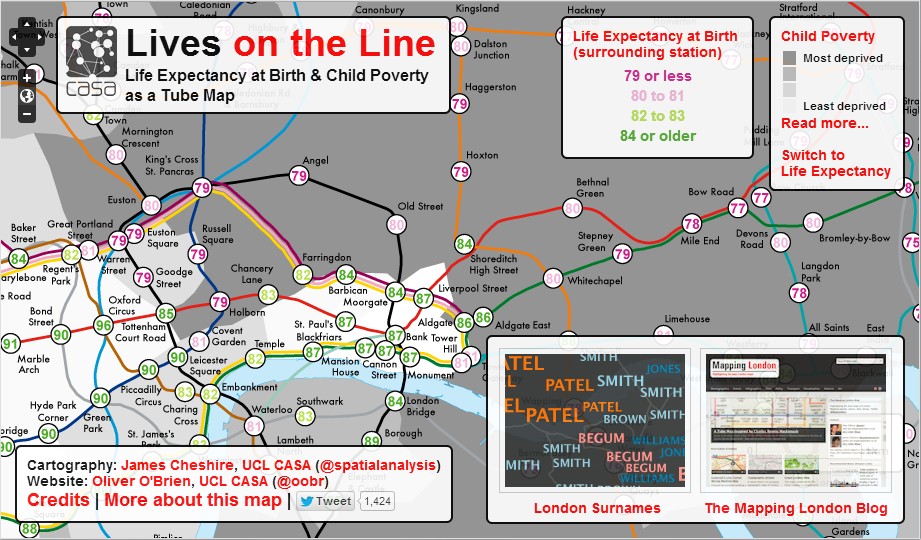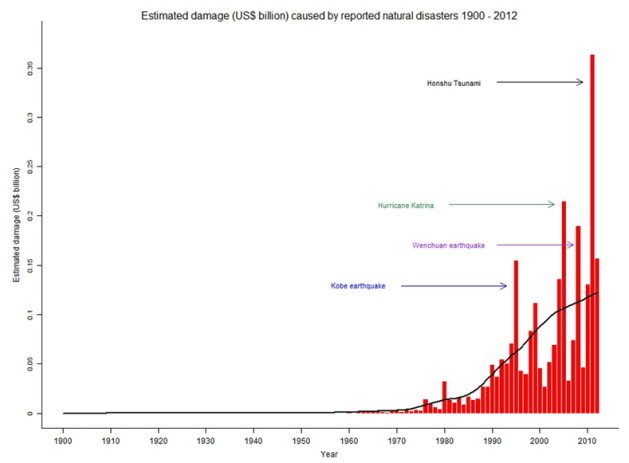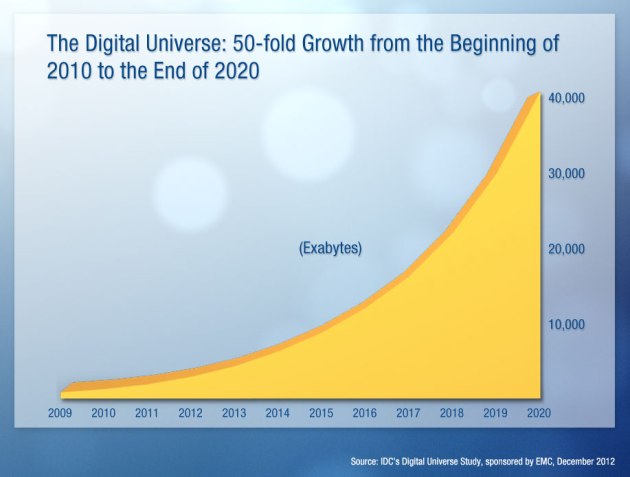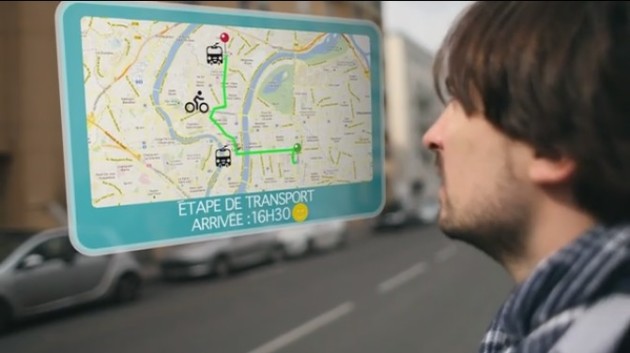
(Birmingham’s Social Media Cafe, where individuals from every part of the city share their experience using social media to promote their businesses and community initiatives. Photograph by Meshed Media)
The Smart Cities movement is sometimes criticised for appearing to focus mainly on the application of technology to large-scale city infrastructures such as smart energy grids and intelligent transportation.
It’s certainly vital that we manage and operate city services and infrastructure as intelligently as possible – there’s no other way to deal with the rapid urbanisation taking place in emerging economies; or the increasing demand for services such as health and social care in the developed world whilst city budgets are shrinking dramatically; and the need for improved resilience in the face of climate change everywhere.
But to focus too much on this aspect of Smart Cities and to overlook the social needs of cities and communities risks forgetting what the full purpose of cities is: to enable a huge number of individual citizens to live not just safe, but rewarding lives with their families.
Maslow’s Hierarchy of Needs identifies our most basic requirements to be food, water, shelter and security. The purpose of many city infrastructures is to answer those needs, either directly (buildings, utility infrastructures and food supply chains) or indirectly (the transport systems that support us and the businesses that we work for).
Important as those needs are, though – particularly to the billions of people in the world for whom they are not reliably met – life would be dull and unrewarding if they were all that we aspired to.
Maslow’s hierarchy next relates the importance of family, friends and “self-actualisation” (which can crudely be described as the process of achieving things that we care about). These are the more elusive qualities that it’s harder to design cities to provide. But unless cities provide them, they will not be successful. At best they will be dull, unrewarding places to live and work, and will see their populations fall as those can migrate elsewhere. At worst, they will create poverty, poor health and ultimately short, unrewarding lives.
A Smart City should not only be efficient, resilient and sustainable; it should improve all of these qualities of life for its citizens.
So how do we design and engineer them to do that?
Tales of the Smart City
Stories about the people whose lives and businesses have been made better by technology tell us how we might answer that question.
In the Community Lover’s Guide to Birmingham, for example, Nick Booth describes the way his volunteer-led social media surgeries helped the Central Birmingham Neighbourhood Forum, Brandwood End Cemetery and Jubilee Debt Campaign to benefit from technology.
Another Birmingham initiative, the Northfield Ecocentre, crowdfunded £10,000 to support their “Urban Harvest” project. The funds helped the Ecocentre pick unwanted fruit from trees in domestic gardens in Birmingham and distribute it between volunteers, children’s centres, food bank customers and organisations promoting healthy eating; and to make some of it into jams, pickles and chutneys to raise money so that in future years the initiative can become self-sustaining.
In the village of Chale on the Isle of Wight, a community not served by the national gas power network and with significant levels of fuel poverty, my colleague Andy Stanford-Clark has helped an initiative not only to deploy smart meters to measure the energy use of each household; but to co-design with residents how they will use that technology, so that the whole community feels a sense of ownership and inclusion in the initiative. The project has resulted in a significant drop in rent arrears as residents use the technology to reduce their utility bills, in some cases by up to 50 percent. Less obviously, the sense of shared purpose has extended to the creation of a communal allotment area in the village and a successful compaign to halve bus fares in the area.
There are countless other examples. Play Fitness “gamify” exercise to persuade children to get fit, and work very hard to ensure that their products are accessible to children in communities of any level of wealth. Casserole Club use social media to introduce people who can’t cook for themselves to people who are prepared to volunteer to cook for others. The West Midlands Collaborative Commerce Marketplace uses analytics technology to help it’s 10,000 member businesses win more than £4billion in new contracts each year. … and so on.
None of these initiatives are purely to do with technology. But they all use technologies that simply were not available and accessible as recently as a few years ago to achieve outcomes that are important to cities and communities. By understanding how the potential of technology was apparent to the stakeholders in such initiatives, why it was affordable and accessible to them, and how they acquired the skills to exploit it, we can learn how to design Smart Cities in a way that encourages widespread grass-roots, localised innovation.
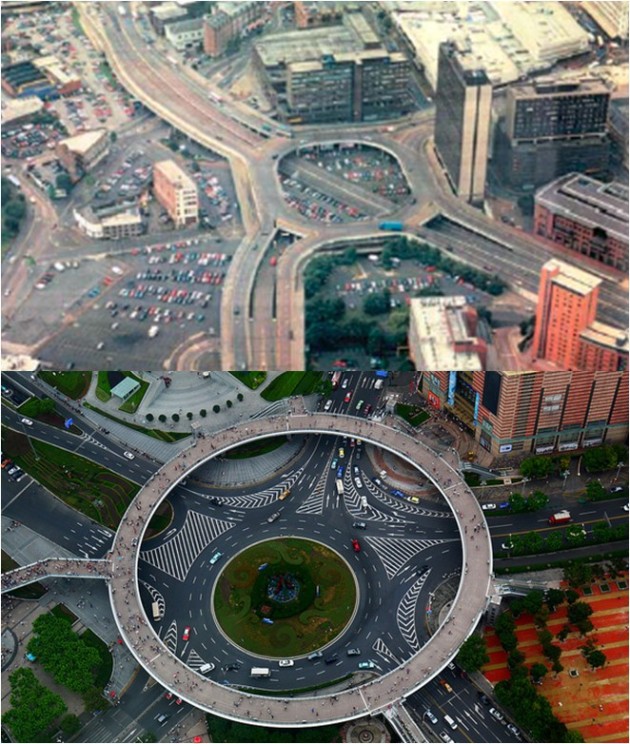
(Top: Birmingham’s Masshouse Circus roundabout, part of the inner-city ringroad that famously impeded the city’s growth until it was demolished. Photo by Birmingham City Council. Bottom: Pedestrian roundabout in Lujiazui, China, constructed over a busy road junction, is a large-scale city infrastructure that balances the need to support traffic flows through the city with the importance that Jane Jacobs first described of allowing people to walk freely about the areas where they live and work. Photo by ChrisUK)
A tale of two roundabouts
History tells us that we should not assume that it will be straightforward to design Smart Cities to achieve that objective, however.
A measure of our success in building the cities we know today from the generations of technology that shaped them – concrete, cars and lifts – is the variation in life expectancy across them. In the UK, it’s common for life expectancy to vary by around 20 years between the poorest and richest parts of the same city.
That staggering difference is the outcome of a complex set of issues including the availability of education and opportunity, lifestyle factors such as diet and exercise, and the accessibility of city services. But a significant influence on many of those issues is the degree to which the large-scale infrastructures built to support our physiological needs and the demands of the economy also create a high-quality environment for daily life.
The photograph on the right shows two city transport infrastructures that are visually similar, but that couldn’t be more different in their influence on the success of the cities that they are part of.
The picture at the top shows Masshouse Circus in Birmingham in 2001 shortly before it was demolished. It was constructed in the 1960s as part of the city’s inner ring-road, intended to improve connectivity to the national economy through the road network. However, the impact of the physical barrier that it created to pedestrian traffic can be seen by the stark difference in land value inside and outside the “concrete collar” of the ring-road. Inside the collar, land is valuable enough for tall office blocks to be constructed on it; whilst outside it is of such low value that it is used as a ground-level carpark.
In contrast, the pedestrian roundabout in Lujiazui, China pictured at the bottom, constructed over a busy road junction, balances the need to support traffic flows through the city with the need for people to walk freely about the areas in which they live and work. As can be seen from the people walking all around it, it preserves the human vitality of an area that many busy roads flow through.
We should take insight from these experiences when considering the design of Smart City infrastructures. Unless those infrastructures are designed to be accessible to and usable by citizens, communities and local businesses, they will be as damaging as poorly constructed buildings and poorly designed transport networks. If that sounds extreme, then consider the dangers of cyber-stalking, or the implications of the gun-parts confiscated from a suspected 3D printing gun factory in Manchester last year that had been created on general purpose machinery from digital designs shared through the internet. Digital technology has life and death implications in the real world.
For a start, we cannot take for granted that city residents have the basic ability to access the internet and digital technology. Some 18% of adults in the UK have never been online; and children today without access to the internet at home and in school are at an enormous disadvantage. As digital technology becomes even more pervasive and important, the impact of this digital divide – within and between people, cities and nations – will become more severe. This is why so many people care passionately about the principle of “Net Neutrality” – that the shared infrastructure of the internet provides the same service to all of its users; and does not offer preferential access to those individuals or corporations able to pay for it.
These issues are very relevant to cities and their digital strategies and governance. The operation of any form of network requires physical infrastructure such as broadband cables, wi-fi and 4G antennae and satellite dishes. That infrastructure is regulated by city planning policies. In turn, those planning policies are tools that cities can and should use to influence the way in which technology infrastructure is deployed by private sector service providers.

(Photograph of Aesop’s fable “The Lion and the Mouse” by Liz West)
Little and big
Cities are enormous places in which what matters most is that millions of individually small matters have good outcomes. They work well when their large scale systems support the fine detail of life for every one of their very many citizens: when “big things” and “little things” work well together.
A modest European or US city might have 200,000 to 500,000 inhabitants; a large one might have between one and ten million. The United Nations World Urbanisation Prospects 2011 revision recorded 23 cities with more than 10 million population in 2011 (only six of them in the developed world); and predicted that there would be nearly 40 by 2025 (only eight of them in the developed world – as we define it today). Overall, between now and 2050 the world’s urban population will double from 3 billion to 6 billion.
A good example of the challenges that this enormous level of urbanisation is already creating is the supply of food. One hectare of highly fertile, intensively farmed land can feed 10 people. Birmingham, my home city, has an area of 60,000 hectares of relatively infertile land, most of which is not available for farming at all; and a population of around 1 million. Those numbers don’t add up to food self-sufficiency; and Birmingham is a very low-density city – between one-half and one-tenth as dense as the growing megacities of Asia and South America. Feeding the 7 to 10 billion people who will inhabit the planet between now and 2050, and the 3 to 6 billion of them that will live in dense cities, is certainly a challenge on an industrial scale.
In contrast, Casserole Club, the Northfield Eco-Centre, the Chale Project and many other initiatives around the world have demonstrated the social, health and environmental benefits of producing and distributing food locally. Understanding how to combine the need to supply food at city-scale with the benefits of producing it locally and socially could make a huge difference to the quality of urban lives.
The challenge of providing affordable broadband connectivity throughout cities demonstrates similar issues. Most cities and countries have not yet addressed that challenge: private sector network providers will not deploy connectivity in areas which are insufficiently economically active for them to make a profit, and Government funding is not yet sufficient to close the gap.
In his enjoyable and insightful book “Smart Cities: Big Data, Civic Hackers, and the Quest for a New Utopia“, Anthony Townsend describes a grass-roots effort by civic activists to provide New York with free wi-fi connectivity. I have to admire the vision and motivation of those involved, but – rightly or wrongly; and as Anthony describes – wi-fi has ultimately evolved to be dominated by commercial organisations.
As technology continues to improve and to reduce in price, the balance of power between large, commercial, resource-rich institutions and small, agile, resourceful grassroots innovators will continue to change. Technologies such as Cloud Computing, social media, 3D printing and small-scale power generation are reducing the scale at which many previously industrial technologies are now economically feasible; however, it will remain the case for the foreseeable future that many city infrastructures – physical and digital – will be large-scale, expensive affairs requiring the buying power and governance of city-scale authorities and the implementation resources of large companies.
But more importantly, neither small-scale nor large-scale solutions alone will meet all of our needs. Many areas in cities – usually those that are the least wealthy – haven’t yet been provided with wi-fi or broadband connectivity by either.
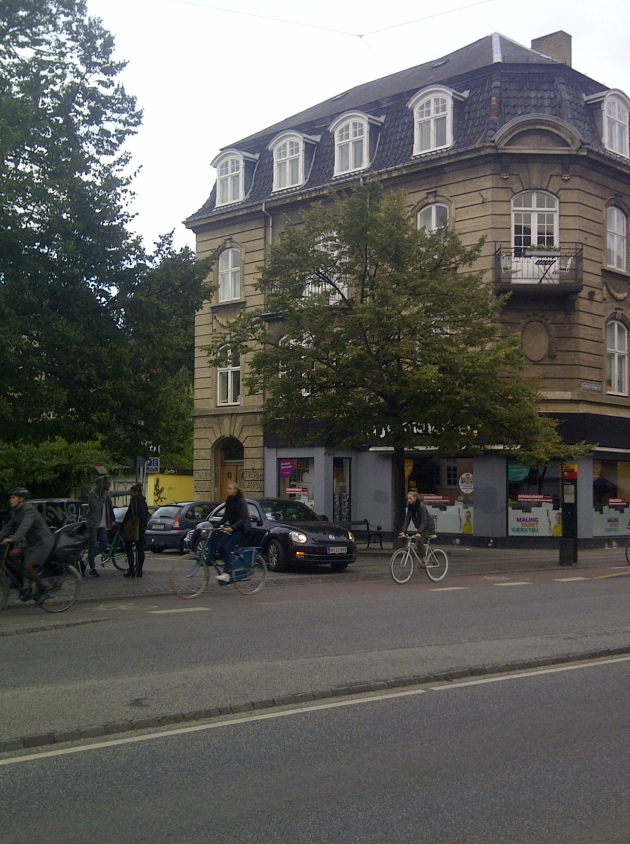
(A well designed urban interface between people and infrastructure. Cars in Frederiksberg, Copenhagen wishing to join a main road must give way to cyclists and pedestrians passing along it)
We need to find the middle ground between the motivations, abilities and cultures of large companies and formal institutions on one hand; and those of agile, local innovators and community initiatives on the other. The pilot project to provide broadband connectivity and help using the internet to Castle Vale in Birmingham is a good example of finding that balance.
And I am optimistic that we can find it more often. Whilst Anthony is rightly critical of approaches to designing and building city systems that are led by technology, or that overlook the down-to-earth and sometimes downright “messy” needs of people and communities for favour of unrealistic technocratic and corporate utopias; the reality of the people I know that are employed by large corporations on Smart City projects is that they are acutely aware of the limitations as well as the value of technology, and are passionately committed to the human value of their work. That passion is often reflected in their volunteered commitment to “civic hacking“, open data initiatives, the teaching of technology in schools and other activities that help the communities in which they live to benefit from technology.
But rather than relying on individual passion and integrity, how do we encourage and ensure that large-scale investments in city infrastructures and technology enable small-scale innovation, rather than stifle it?
Smart urbanism and massive/small innovation
I’ve taken enormous inspiration in recent years from the architect Kelvin Campbell whose “Massive / Small” concept and theory of “Smart Urbanism” are based on the belief that successful cities emerge from physical environments that encourage “massive” amounts of “small”-scale innovation – the “lively, diversified city, capable of continual, close- grained improvement and change” that Jane Jacobs described in “The Death and Life of Great American Cities“.
We’ll have to apply similar principles in order for large-scale city technology infrastructures to support localised innovation and value-creation. But what are the practical steps that we can take to put those principles into practise?
Step 1: Make institutions accessible
There’s a very basic behaviour that most of us are quite bad at – listening. In particular, if the institutions of Smart Cities are to successfully create the environment in which massive amounts of small-scale innovation can emerge, then they must listen to and understand what local activists, communities, social innovators and entrepreneurs want and need.
Many large organisations – whether they are local authorities or private sector companies – are poor at listening to smaller organisations. Their decision-makers are very busy; and communications, engagement and purchasing occur through formally defined processes with legal, financial and confidentiality clauses that can be difficult for small or informal organisations to comply with. The more that we address these barriers, the more that our cities will stimulate and support small-scale innovation. One way to do so is through innovations in procurement; another is through the creation of effective engagements programmes, such as the Birmingham Community Healthcare Trust’s “Healthy Villages” project which is listening to communities expressing their need for support for health and wellbeing. This is why IBM started our “Smarter Cities Challenge” which has engaged hundreds of IBM’s Executives and technology experts in addressing the opportunities and challenges of city communites; and in so doing immersed them in very varied urban cultures, economies, and issues.
But listening is also a personal and cultural attitude. For example, in contrast to the current enthusiasm for cities to make as much data as possible available as “open data”, the Knight Foundation counsel a process of engagement and understanding between institutions and communities, in order to identify the specific information and resources that can be most usefully made available by city institutions to individual citizens, businesses and social organisations.

(Delegates at Gov Camp 2013 at IBM’s Southbank office, London. Gov Camp is an annual conference which brings together anyone interested in the use of digital technology in public services. Photo by W N Bishop)
In IBM, we’ve realised that it’s important to us to engage with, listen to and support small-scale innovation in its many forms when helping our customers and partners pursue Smarter City initiatives; from working with social enterprises, to supporting technology start-ups through our Global Entrepreneur Programme, to engaging with the open data and civic hacking movements.
More widely, it is often talented, individual leaders who overcome the barriers to engagement and collaboration between city institutions and localised innovation. In “Resilience: why things bounce back“, Andrew Zolli describes many examples of initiatives that have successfully created meaningful change. A common feature is the presence of an individual who shows what Zolli calls”translational leadership“: the ability to engage with both small-scale, informal innovation in communities and large-scale, formal institutions with resources.
Step 2: Make infrastructure and technology accessible
Whilst we have a long way to go to address the digital divide, Governments around the world recognise the importance of access to digital technology and connectivity; and many are taking steps to address it, such as Australia’s national deployment of broadband internet connectivity and the UK’s Urban Broadband Fund. However, in most cases, those programmes are not sufficient to provide coverage everywhere.
Some businesses and social initiatives are seeking to address this shortfall. CommunityUK, for example, are developing sustainable business models for providing affordable, accessible connectivity, and assistance using it, and are behind the Castle Vale project in Birmingham. And some local authorities, such as Sunderland and Birmingham, have attempted to provide complete coverage for their citizens – although just how hard it is to achieve that whilst avoiding anti-competition issues is illustrated by Birmingham’s subsequent legal challenges.
We should also tap into the enormous sums spent on the physical regeneration of cities and development of property in them. As I first described in June last year, while cities everywhere are seeking funds for Smarter City initiatives, and often relying on central government or research grants to do so, billions of Pounds, Euros, and Dollars are being spent on relatively conventional property development and infrastructure projects that don’t contribute to cities’ technology infrastructures or “Smart” objectives.
Local authorities could use planning regulations to steer some of that investment into providing Smart infrastructure, basic connectivity, and access to information from city infrastructures to citizens, communities and businesses. Last year, I developed a set of “Smart City Design Principles” on behalf a city Council considering such an approach, including:
Principle 4: New or renovated buildings should be built to contain sufficient space for current and anticipated future needs for technology infrastructure such as broadband cables; and of materials and structures that do not impede wireless networks. Spaces for the support of fixed cabling and other infrastructures should be easily accessible in order to facilitate future changes in use.
Principle 6: Any development should ensure wired and wireless connectivity is available throughout it, to the highest standards of current bandwidth, and with the capacity to expand to any foreseeable growth in that standard.
Step 3: Support collaborative innovation
Small-scale, local innovations will always take place, and many of them will be successful; but they are more likely to have significant, lasting, widespread impact when they are supported by city institutions with resources.
That support might vary from introducing local technology entrepreneurs to mentors and investors through the networks of contacts of city leaders and their business partners; through to practical assistance for social enterprises, helping them to put in place very basic but costly administration processes to support their operations.
City institutions can also help local innovations to thrive simply by becoming their customers. If Councils, Universities and major local employers buy services from innovative local providers – whether they be local food initiatives such as the Northfield Ecocentre or high-tech innovations such as Birmingham’s Droplet smartphone payment service – then they provide direct support to the success of those businesses.
In Birmingham,for example, Finance Birmingham (a Council-owned venture capital company) and the Entrepreneurs for the Future (e4F) scheme provide real, material support to the city’s innovative companies; whilst Bristol’s Mayor George Ferguson and Lambeth’s Council both support their local currencies by allowing salaries to be paid in them.
It becomes more obvious why stakeholders in a city might become involved in collaborative innovation when they have the opportunity to co-create a clear set of shared priorities. Those priorities can be compared to the objectives of innovative proposals seeking support, whether from social initiatives or businesses; used as the basis of procurement criteria for goods, services and infrastructure; set as the objectives for civic hacking and other grass-roots creative events; or even used as the criteria for funding programmes for new city services, such as the “Future Streets Incubator” that will shortly be launched in London as a result of the Mayor of London’s Roads Task Force.
In this context, businesses are not just suppliers of products and services, but also local institutions with significant supply chains, carbon and economic footprints, purchasing power and a huge number of local employees. There are many ways such organisations can play a role in supporting the development of an open, Smarter, more sustainable city.
The following “Smart City Design Principles” promote collaborative innovation in cities by encouraging support from development and regeneration initiatives:
Principle 12: Consultations on plans for new developments should fully exploit the capabilities of social media, virtual worlds and other technologies to ensure that communities affected by them are given the widest, most immersive opportunity possible to contribute to their design.
Principle 13: Management companies, local authorities and developers should have a genuinely engaging presence in social media so that they are approachable informally.
Principle 14: Local authorities should support awareness and enablement programmes for social media and related technologies, particularly “grass roots” initiatives within local communities.
Step 4: Promote open systems
A common principle between the open data movement; civic hacking; localism; the open government movement; and those who support “bottom-up” innovations in Smart Cities is that public systems and infrastructure – in cities and elsewhere – should be “open”. That might mean open and transparent in their operation; accessible to all; or providing open data and API interfaces to their technology systems so that citizens, communities and businesses can adapt them to their own needs. Even better, it might mean all of those things.
The “Dublinked” information sharing partnership, in which Dublin City Council, three surrounding County Councils and service providers to the city share information and make it available to their communities as “open data”, is a good example of the benefits that openness can bring. Dublinked now makes 3,000 datasets available to local authority analysts; to researchers from IBM Research and the National University of Ireland; and to businesses, entrepreneurs and citizens. The partnership is identifying new ways for the city’s public services and transport, energy and water systems to work; and enabling the formation of new, information-based businesses with the potential to export the solutions they develop in Dublin to cities internationally. It is putting the power of technology and of city information not only at the disposal of the city authority and its agencies, but also into the hands of communities and innovators.
In a digital future, the more that city infrastructures and services provide open data interfaces and APIs, the more that citizens, communities and businesses will be able to adapt the city to their own needs. This is the modern equivalent of the grid system that Jane Jacobs promoted as the most adaptable urban form. A grid structure is the basis of Edinburgh’s “New Town”, often regarded as a masterpiece of urban planning that has proved adaptable and successful through the economic and social changes of the past 250 years, and is also the starting point for Kelvin Campbell’s work.
But open data interfaces and APIs will only be widely exploitable if they conform to common standards. In order to make it possible to do something as simple as changing a lightbulb, we rely on open standards for the levels of voltage and power from our electricity supply; the physical dimensions of the socket and bulb and the characteristics of their fastenings; specifications of the bulb’s light and heat output; and the tolerance of the bulb and the fitting for the levels of moisture found in bathrooms and kitchens. Cities are much more complicated than lightbulbs; and many more standards will be required on order for us to connect to and re-configure their systems easily and reliably.
Open standards are also an important tool in avoiding city systems becoming “locked-in” to any particular supplier. By specifying common characteristics that all systems are required to demonstrate, it becomes more straightforward to exchange one supplier’s implementation for another.
Some standards that Smarter City infrastructures can use are already in place – for example, Web services and REST that specify the general ways in which computer systems interact, and the Common Alerting Protocol which is more specific to interactions between systems that monitor and control the physical world. But many others will need to be invented and encouraged to spread. The City Protocol Society is one organisation seeking to develop those new standards; and the British Standards Institute recently published the first set of national standards for Smarter Cities in the UK, including a standard for the interoperability of data between Smart City systems.
Some open source technologies will also be pivotal; open source (software whose source code is freely available to anyone, and which is usually written by unpaid volunteers) is not the same as open standards (independently governed conventions that define the way that technology from any provider behaves). But some open source technologies are so widely used to operate the internet infrastructures that we have become accustomed to – the “LAMP” stack of operating system, web server, database and web progamming language, for example – that they are “de facto” standards that convey some of the benefits of wide usability and interoperability of open standards. For example, IBM recently donated MQTT, a protocol for connecting information between small devices such as sensors and actuators in Smart City systems to the open source community, and it is becoming increasingly widely adopted as a consequence.
Once again, local authorities can contribute to the adoption of open standards through planning frameworks and procurement practises:
Principle 7: Any new development should demonstrate that all reasonable steps have been taken to ensure that information from its technology systems can be made openly available without additional expenditure. Whether or not information is actually available will be dependent on commercial and legal agreement, but it should not be additionally subject to unreasonable expenditure. And where there is no compelling commercial or legal reason to keep data closed, it should actually be made open.
Principle 8: The information systems of any new development should conform to the best available current standards for interoperability between IT systems in general; and for interoperability in the built environment, physical infrastructures and Smarter Cities specifically.
Finally, design skills will be crucial both to creating interfaces to city infrastructures that are truly useful and that encourage innovation; and in creating innovations that exploit them that in turn are useful to citizens.
At the technical level, there is already a rich corpus of best practise in the design of interfaces to technology systems and in the architecture of technology infrastructures that provide them.
But the creativity that imagines new ways to use these capabilities in business and in community initiatives will also be crucial. The new academic discipline of “Service Science” describes how designers can use technology to create new value in local contexts; and treats services such as open data and APIs as “affordances” – capabilities of infrastructure that can be adapted to the needs of an individual. In the creative industries, “design thinkers” apply their imagination and skills to similar subjects.
Step 5: Provide common services
At the 3rd EU Summit on Future Internet, Juanjo Hierro, Chief Architect for the FI-WARE “future internet platform” project, identified the specific tools that local innovators need in order to exploit city information infrastructures. They include real-time access to information from physical city infrastructures; tools for analysing “big data“; and access to technologies to ensure privacy and trust.
The Dublinked information sharing partnership is already putting some of these ideas into practise. It provides assistance to innovators in using, analysing and visualising data; and now makes available realtime data showing the location and movements of buses in the city. The partnership is based on specific governance processes that protect data privacy and manage the risk associated with sharing data.
As we continue to engage with communities of innovators in cities, we will discover further requirements of this sort. Imperial College’s “Digital Cities Exchange” research programme is investigating the specific digital services that could be provided as enabling infrastructure to support innovation and economic growth in cities, for example. And the British Standards Institute’s Smart Cities programme includes work on standards that will enable small businesses to benefit from Smart City infrastructure.
Local authorities can adapt planning frameworks to encourage the provision of these services:
Principle 9: New developments should demonstrate that they have considered the commercial viability of providing the digital civic infrastructure services recommended by credible research sources.
Step 6: Establish governance of the information economy
From the exponential growth in digital information we’ve seen in recent years, to the emergence of digital currencies such as Bitcoin, to the disruption of traditional industries by digital technology; it’s clear that we are experiencing an “information revolution” just as significant as the “industrial revolution” of the 18th and 19th centuries. We often refer to the resulting changes to business and society as the development of an “information economy“.
But can we speak in confidence of an information economy when the basis of establishing the ownership and value of its fundamental resource – digital information – is not properly established?
A great deal of law and regulation already applies to information, of course – such as the European Union’s data privacy legislation. But practise in this area is far less established than the laws governing the ownership of physical and intellectual property and the behaviour of the financial system that underlie the rest of the economy. This is evident in the repeated controversies concerning the use of personal information by social media businesses, consumer loyalty schemes, healthcare providers and telecommunications companies.
The privacy, security and ownership of information, especially personal information, are perhaps the greatest challenges of the digital age. But that is also a reflection of their importance to all aspects of our lives. Jane Jacobs’ description of urban systems in terms of human and community behaviour was based on those concepts, and is still regarded as the basis of our understanding of cities. New technologies for creating and using information are developing so rapidly that it is not only laws specifically concerning them that are failing to keep up with progress; laws concerning the other aspects of city systems that technology is transforming are failing to adapt quickly enough too.
A start might be to adapt city planning regulations to reflect and enforce the importance of the personal information that will be increasingly accessed, created and manipulated by city systems:
Principle 21: Any information system in a city development should provide a clear policy for the use of personal information. Any use of that information should be with the consent of the individual.
The triumph of the commons
I wrote last week that Smarter Cities should be a “middle-out” economic investment – in other words, an investment in common interests – and compared them to the Economist’s report on the efforts involved in distributing the benefits of the industrial revolution to society at large rather than solely to business owners and the professional classes.
One of the major drivers for the current level of interest in Smarter Cities and technology is the need for us to adapt to a more sustainable way of living in the face of rising global populations and finite resources. At large scale, the resources of the world are common; and at local scale, the resources of cities are common too.
For four decades, it has been widely assumed that those with access to common resources will exploit them for short term gain at the expense of long term sustainability – this is the “tragedy of the commons” first described by the economist Garrett Hardin. But in 2009, Elinor Ostrum won the Nobel Prize for economics by demonstrating that the “tragedy” could be avoided, and that a community could manage and use shared resources in a way that was sustainable in the long-term.
Ostrum’s conceptual framework for managing common resources successfully is a set of criteria for designing “institutions” that consist of people, processes, resources and behaviours. These need not necessarily be formal political or commercial institutions, they can also be social structures. It is interesting to note that some of those criteria – for example, the need for mechanisms of conflict resolution that are local, public, and accessible to all the members of a community – are reflected in the development over the last decade of effective business models for carrying out peer-to-peer exchanges using social media, supported by technologies such as reputation systems.
Of course, there are many people and communities who have championed and practised the common ownership of resources regardless of the supposed “tragedy” – not least those involved in the Transition movement founded by Rob Hopkins, and which has developed a rich understanding of how to successfully change communities for the better using good ideas; or the translational leaders described by Andrew Zolli. But Elinor Ostrum’s ideas are particularly interesting because they could help us to link the design, engineering and governance of Smarter Cities to the achievement of sustainable economic and social objectives based on the behaviour of citizens, communities and businesses.
Combined with an understanding of the stories of people who have improved their lives and communities using technology, I hope that the work of Kelvin Campbell, Rob Hopkins, Andrew Zolli, Elinor Ostrum and many others can inspire technologists, urban designers, architects and city leaders to develop future cities that fully exploit modern technology to be efficient, resilient and sustainable; but that are also the best places to live and work that we can imagine, or that we would hope for for our children.
Cities created by people like that really would be Smart.








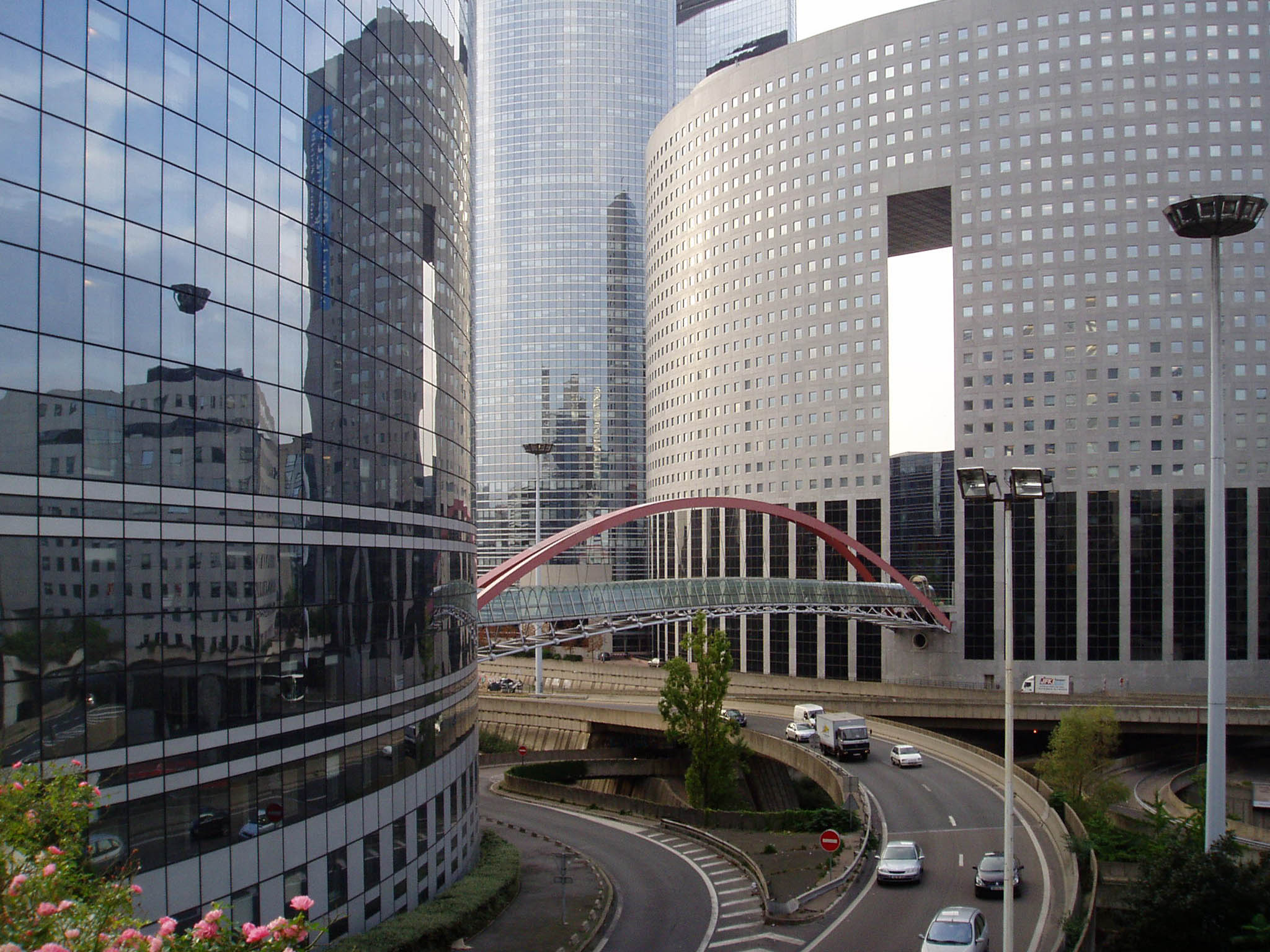


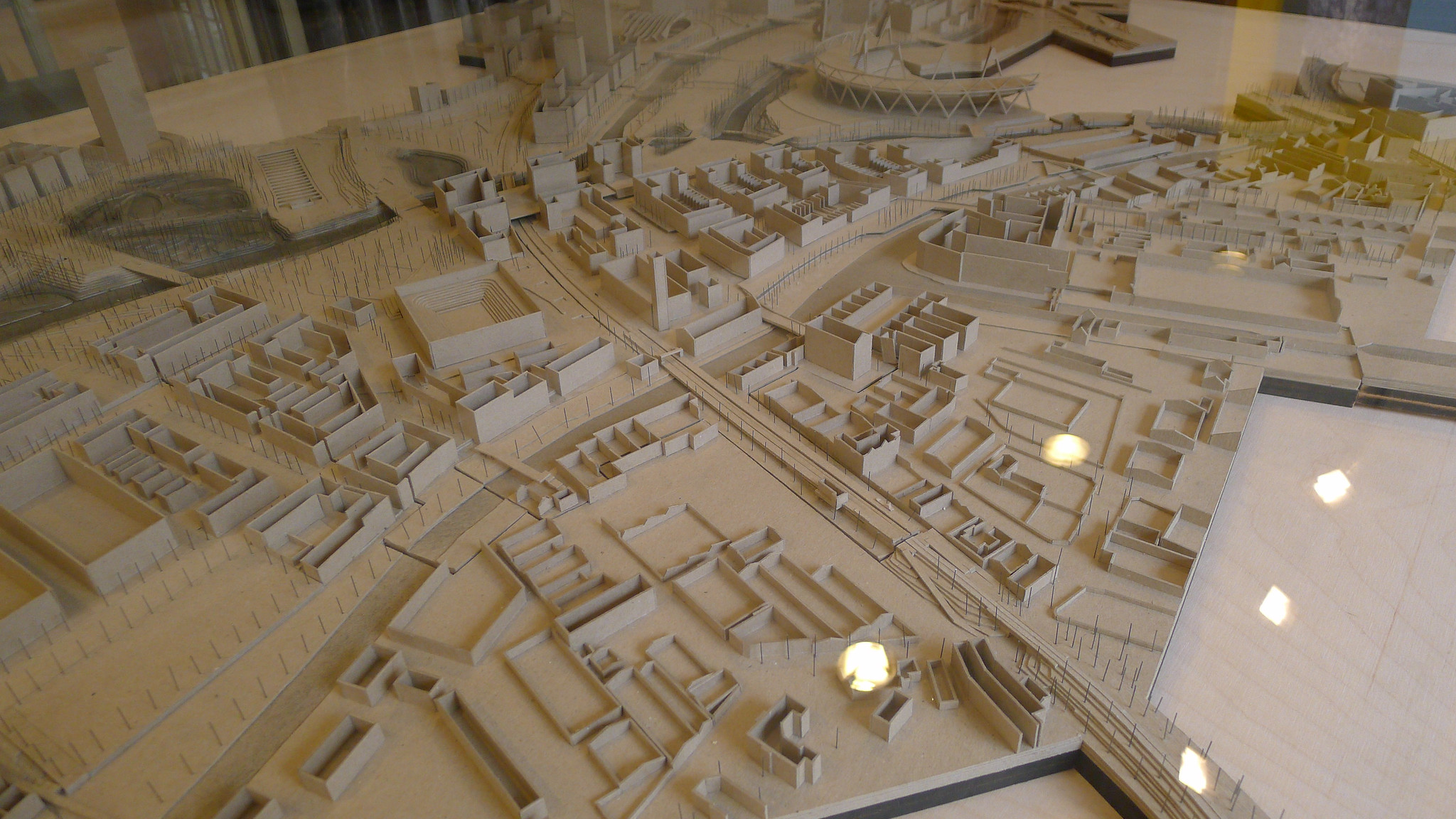



![(The sound artists FA-TECH [http://fa-tech.tumblr.com/] improvising in Shoreditch, London. Shoreditch's combination of urban character, cheap rents and proximity to London's business, financial centres and culture led to the emergence of a thriving technology startup community - although that community's success is now driving rents up, challenging some of the characteristics that enabled it.)](https://rickrobinson.files.wordpress.com/2015/01/6172318975_bcc84af6b2_o.jpg)
